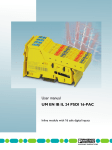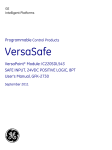Download Procaster User manual
Transcript
Procaster User Manual Procaster AMTX200 AM Transmitter Important! Safety Warning Never mount near electrical power lines! Safety Ground Warning For the built-in lightning protection to work properly, the Procaster grounding lug must be properly grounded. Consult your local electrical safety standards. Transmitter RF Ground For maximum range, the Procaster grounding lug must also be connected to a good RF (radio frequency) ground. Electrical and RF grounds are often considered to be the same, but sometimes they are not. A good RF ground will cause maximum current to flow in the antenna resulting in greater radiation and best range. IF YOU ARE NOT GETTING SUFFICIENT RANGE, YOU MAY HAVE TO EXPERIMENT WITH DIFFERENT RF GROUNDING – SEE RF GROUNDING SECTION AT THE END OF THIS USER MANUAL! Chezradio 1 of 20 5 January, 2014 Procaster User Manual Quick Setup This Quick Setup section is to get you up and running with minimal reading. For best results, greater detail is covered in the Installation/Operation section. 1. In the Procaster, set broadcast frequency using the internal option switch. Use the highest “clear” frequency available for best range. (“clear” means no music or talking – static is OK). Note: quiet static might suggest that another transmitter is present – if that’s the case, use another frequency. 2. Assemble the 3 antenna sections by lining up the black dot on one section with the edge of the mating section. Secure sections with the provided hose clamps. 3. Remove the plastic shipping protective bolt tubes and discard them and attach the antenna to the side of the transmitter using the 2 nuts provided. 4. Mount the transmitter vertically as high as possible in a clear area away from trees, power lines and other obstructions. 5. Connect a 12 or 14 gauge wire from the ground lug to a suitable ground. (grounding rod in the earth, water pipe, existing electrical ground, metal roof etc. Important: for best range, you may have to experiment – see RF Grounding section. 6. Connect the 4 conductor wire as follows: Procaster end… Shield to SHLD (shield wire is the bare wire that contacts the foil) RED to +12V BLACK to 0V GREEN to AUD WHITE to AUD+ Studio Interface end… RED to +12V BLACK to 0V GREEN to AUD WHITE to AUD+ Note: the shield is only connected at the Procaster end. At the Studio Interface – simply cut the shield off. Chezradio 2 of 20 5 January, 2014 Procaster User Manual 7. Plug the wall adapter into the Studio Interface (do not connect the audio yet). 8. Once the broadcast channel is set, turn the ANTENNA TUNING CAPACITOR (this is the yellow or blue circular component labeled C18 near the yellow antenna wire) using the included tuning tool until a maximum reading is seen on the TUNING METER. Place the recessed end of the tuning tool over the brass slotted screw of the trimmer capacitor and turn in either direction until a maximum reading is seen on the tuning meter. Stand away from the antenna when tuning as your body will affect the results. Do not adjust the METER TRIMMER POTENTIOMETER! – this is only adjusted if the meter reads fully to the right off-scale – in this case you will not be able to see a maximum. The only purpose of the tuning meter is to indicate a MAXIMUM – the numbers are not important. For best results keep large metal objects such as elevating work platforms (Skyjacks) and yourself, away from the antenna while doing this. 9. Close up the Procaster. Tighten the 2 cover screws evenly – don’t over-tighten! 10. Connect audio. 11. It may be necessary to adjust the gain control on the Studio Interface to suit the audio source being used. Some headphone jacks on MP3 players have a low output voltage. To increase gain on the Studio Interface, adjust the gain control CW (accessed through a hole in the side of the Studio Interface) using a small screwdriver. 12. Inside the Studio Interface, adjust the desired modulation depth to suit your listening preferences. 13. Inside the Studio Interface, select the desired compression using the jumper… Chezradio 1:1 2:1 (default) 5:1 10:1 3 of 20 5 January, 2014 Procaster User Manual Installation and Operation Step 1 Choose a Quiet Channel Drive around your chosen broadcast area and listen for clear channels. Note: car radios are usually more sensitive than portables, so that should be considered too. If you want to broadcast at night, you would have to check if the channel is clear then. It's more difficult to broadcast at night because sky-waves from higher-powered radio stations reach into your broadcast area and will reduce your effective transmit range; so bear that in mind. Try to choose one of the highest 42 channels available for the Procaster by setting the option switch accordingly. The higher the frequency, the better the range due to the restrictive short antenna length. Step 2 Choose a Location for Installation Locate the Procaster in as clear an area as possible away from metal structures, power lines, trees and other obstructions which can absorb and deflect your signal. Higher mounted antennas work best and give best range. Mounting methods vary - see Step 4. Make sure you can access the transmitter for tuning once it is in its final position. A good height above earth ground is about 25 feet. The roof of a 2-storey building is a good choice. Note: you cannot tune the transmitter on the ground and then raise it into its final position – the tuning will be off and the range will be poor. It has to be tuned only when it is in its final position. Step 3 Assemble Antenna The antenna consists of 3 aluminum tubes (large 5/8in, medium 1/2in and small 3/8in) which are assembled together. These sections are held together using 2 stainless steel pipe clamps fastened at the mid-point of the cut slots. Join the large tube to the medium tube o insert the medium tube into the slotted end of the large tube o line up the black dot on the medium tube with the edge of the large tube o tighten pipe clamp snugly using a ¼ in nut driver Join the small tube to the medium tube o insert the small tube into the slotted end of the medium tube o line up the black dot on the small tube with the edge of the medium tube o tighten pipe clamp snugly using a ¼ in nut driver Fasten the assembled mast to the transmitter using (2) locknuts o Tighten snugly (don't over tighten) Antenna assembly is now complete Chezradio 4 of 20 5 January, 2014 Procaster User Manual Assembling the antenna Step 4 Mount External Transmitter In all mounting cases, make sure you can reach the unit for tuning once installed! The antenna must be clear of all objects. If mounting part way up a metal tower, make sure the Procaster is at least 2 ft away from the tower on an extension arm otherwise the tower will cause induced loss of signal. Direct wall mounting The Procaster can be mounted directly to a flat vertical surface using the 4 holes in the case mounting plate. Make sure that there is sufficient space between the antenna mast and the rear wall such that snow/ice does not cause a short. Direct wall mounting with standoff brackets If you need to install the Procaster further away from the wall, use Radio Shack brackets #15-883. This will give an extra 4 in of clearance. Pole mounting For pole mounting use the included U-bolts as shown in the following picture. These U-bolts will accommodate tubing up to 1-5/8 in diameter. Chezradio 5 of 20 5 January, 2014 Procaster User Manual U-bolts for pole mounting Step 5 Install Ground Connect the copper grounding lug shown below to a suitable ground. Grounding lug Good grounding is extremely important and required for safe operation of the lightning protection circuitry and also an important part of optimum antenna performance. Typical grounds include: Copper clad steel grounding rod at least 8ft into earth ground Water pipe ground Radial ground system Metal roof Refer to the Optimizing your Range Tip #4 for more details. Chezradio 6 of 20 5 January, 2014 Procaster User Manual Step 6 Connect Power and Audio Wiring The Procaster connects to the Studio Interface with the supplied 4 conductor shielded cable. Because the audio is balanced and the power consumption is low, up to 250ft of 22 AWG shielded wire (Belden 8723 or equivalent) can be used. System comes with 50ft standard – optional 100ft. Proceed as follows: Open the Procaster cover by removing the 2 screws Insert the 4 conductor cable through the liquid-tight grommet on the underside Add electrical tape to cover exposed foil to prevent possible shorting Connect 5 places… o SHIELD to SHLD * o RED to +12V o BLACK to 0V o GREEN to AUD o WHITE to AUD + Tighten nut on liquid-tight grommet * The shield wire is the bare wire that contacts the foil inside the cable. Only connect the shield wire at the Procaster end – leave the shield unconnected at the Studio Interface end. Wiring the Procaster (shield wire connected) Chezradio 7 of 20 5 January, 2014 Procaster User Manual Step 7 Connect to indoor Studio Interface Module Bring the 4 conductor cable into the studio area. Remove the 4 screws from the studio interface enclosure Remove the cover Pass the 4 conductor cable through the side hole Add electrical tape to cover exposed foil to prevent possible shorting Connect 4 places… o RED to +12V o BLACK to 0V o GREEN to AUD – o WHITE to AUD + Replace the cover and screws Note: the shield wire is NOT connected at this end - simply cut it off. Studio Interface wiring (no shield wire connected at this end) Step 8 Connect an audio source The Procaster is fitted with a universal 3.5mm input jack. It has been designed to accept stereo left and right audio channels and mix them into a mono signal. If you only have a mono signal, you can apply it to either the left or the right input connection. The built-in audio processor has a fairly wide accommodation range and will automatically adjust audio level for optimum sound quality. If you use an external audio processor you can turn off the built-in audio processor by moving the jumper to the ‘off’ position. In addition there is an input audio level adjustment control (normally set at mid-point) accessible through the Studio Interface front panel using a small screwdriver. Chezradio 8 of 20 5 January, 2014 Procaster User Manual Step 9 Power Up the Procaster Connect the AC wall adapter or 12VDC power source. Note: the standard Procaster system is designed to be powered from 12VDC and consumes approximately 100mA (1W). For remote locations with no power available, the entire system can easily be run from a 12V battery charged by a solar panel. Size of panel depends on your location and days of sunlight. Step 10 Choose Channel Frequency To choose the desired broadcast channel and other additional options, the 6-position option switch is used. This switch is located inside the Procaster transmitter case. Note: always choose the highest clear frequency possible. The short length of the antenna is more efficient at higher frequencies and you will get better range. The Procaster is shipped with the following default settings: Channel frequency – 1610kHz Audio Processor Compression – 2:1 Modulation depth - midway Broadcast frequency option switch (1610kHz shown) Channel Settings Chezradio Freq kHz S1 S2 S3 S4 S5 S6 1290 ON ON ON ON ON ON 1300 OFF ON ON ON ON ON 1310 ON OFF ON ON ON ON 1320 OFF OFF ON ON ON ON 1330 ON ON OFF ON ON ON 1340 OFF ON OFF ON ON ON 1350 ON OFF OFF ON ON ON 1360 OFF OFF OFF ON ON ON 9 of 20 5 January, 2014 Procaster User Manual Freq kHz S1 S2 S3 S4 S5 S6 1370 ON ON ON OFF ON ON 1380 OFF ON ON OFF ON ON 1390 ON OFF ON OFF ON ON 1400 OFF OFF ON OFF ON ON 1410 ON ON OFF OFF ON ON 1420 OFF ON OFF OFF ON ON 1430 ON OFF OFF OFF ON ON 1440 OFF OFF OFF OFF ON ON 1450 ON ON ON ON OFF ON 1460 OFF ON ON ON OFF ON 1470 ON OFF ON ON OFF ON 1480 OFF OFF ON ON OFF ON 1490 ON ON OFF ON OFF ON 1500 OFF ON OFF ON OFF ON 1510 ON OFF OFF ON OFF ON 1520 OFF OFF OFF ON OFF ON 1530 ON ON ON OFF OFF ON 1540 OFF ON ON OFF OFF ON 1550 ON OFF ON OFF OFF ON 1560 OFF OFF ON OFF OFF ON 1570 ON ON OFF OFF OFF ON 1580 OFF ON OFF OFF OFF ON 1590 ON OFF OFF OFF OFF ON 1600 OFF OFF OFF OFF OFF ON 1610 ON ON ON ON ON OFF 1620 OFF ON ON ON ON OFF 1630 ON OFF ON ON ON OFF 1640 OFF OFF ON ON ON OFF 1650 ON ON OFF ON ON OFF 1660 OFF ON OFF ON ON OFF 1670 ON OFF OFF ON ON OFF 1680 OFF OFF OFF ON ON OFF 1690 ON ON ON OFF ON OFF 1700 OFF ON ON OFF ON OFF Note: for best range, use 1600kHz and higher Chezradio 10 of 20 5 January, 2014 Procaster User Manual Step 11 Antenna Tuning Important! Once the broadcast channel is set, turn the ANTENNA TUNING CAPACITOR (this is the yellow or blue circular component labeled C18 near the yellow antenna wire) using the included tuning tool until a maximum reading is seen on the TUNING METER. Place the recessed end of the tuning tool over the brass slotted screw of the trimmer capacitor and turn in either direction until a maximum reading is seen on the tuning meter. Stand away from the antenna when tuning as your body will affect the results. Do not adjust the METER TRIMMER POTENTIOMETER! – this is only adjusted if the meter reads fully to the right off-scale – in this case you will not be able to see a maximum. The only purpose of the tuning meter is to indicate a MAXIMUM – the numbers are not important. Antenna tuning Failing to tune C18 properly is the leading cause of poor range! The antenna must be tuned after the Procaster is installed in its final position – you cannot tune the antenna and then raise up the Procaster! Chezradio 11 of 20 5 January, 2014 Procaster User Manual Choosing a lower frequency will result in a lower reading on the tuning meter - this is normal. Antenna tuning is now complete. (Now that was easy!) Step 12 Final Checkout & Adjustments Check your sound level and range by listening on a radio. The broadcast signal should be clear and strong when closer to the transmitter, with more noise heard the further you move away. The built-in audio processor (located in the Studio Interface module) is what makes the Procaster sound like a big station. If you want to use your own external audio processing equipment, the Procaster audio processor can be disabled by moving the audio processor jumper to the ‘off’ position. The Procaster audio processor can be adjusted to suit personal preferences by adjusting the Compression (jumper selectable) and Modulation Depth (variable control) using the bladed end of the tuning tool. Compression and modulation depth controls Audio Processor: Compression boosts quieter parts of the audio to be more equal to the louder parts. This makes the overall audio louder resulting in a stronger signal and greater range. The tradeoff is the subjective audio quality depending on the level of compression. Settings are 1:1, 2:1, 5:1 and 10:1. Default is 2:1. Modulation Depth: Turning the modulation depth control CW increases the audio modulation level of the AM signal. Some additional over modulation (depending on your application) adds 'punch' to the received audio resulting in a stronger, louder signal and greater range. Default is midway. Limiting: Limiting is automatic to prevent sideband 'splatter' and both the above adjustments have no affect on the 'hard limiter' built into the audio processor. Step 13 Secure cover Secure cover by evenly tightening the 2 screws to ensure a weatherproof seal. Congratulations! You have set up your broadcast station. Chezradio 12 of 20 5 January, 2014 Procaster User Manual Optimizing Your Range Overview The original intention of the FCC was to allow broadcasting around the home. Their regulations achieved this by specifying low input power and electrically short antennas. The purpose of this was to minimize any interference with commercial radio stations and their listeners. What is the range? This is probably the #1 question asked. Range for low power transmitters can vary greatly due to many factors: Interfering radio signals from other stations on the same frequency Obstructions such as buildings and trees Transmitter height Quality of the grounding Electrical interference from power lines Sensitivity of the radio receiver Typically you can expect a range of between 1/2 to 2 miles. Poor installation can dramatically reduce that range. For best results, we have compiled the following as a guide: Tip #1 Pick the clearest/quietest frequency in your area that you can. Competing with a commercial radio station, even if far away and weak will severely reduce your range. Tip #2 If you want to transmit at night, make sure that is free also. This may be difficult because at night there may be a cluster of distant stations on every frequency (even if it sounds fairly clear). Tip #3 Mount the Procaster elevated about 25ft or more in an open area as far away from buildings, trees and electrical overhead wires as possible. Bear in mind that you have to be able to reach the transmitter in its final position for tuning. SAFETY WARNING - Never install an antenna close by to any electrical service! Tip #4 Make sure your ground is good. The FCC rules allow for a total of 3 meters (118in) for antenna, transmission line and ground lead. The Procaster has a fixed 104 in electrical antenna length, no transmission line and a ground lug which must be connected to a ground point for lightning protection. That implies that the "ground lead" from the ground lug to the ground point can be up to 14 in long to comply with the 15.219 rules. If you run a long wire from the ground lug to earth ground, an FCC agent might disallow it if he thinks that this ground lead could radiate and thus effectively extend the antenna length in violation of the 15.219 rules. Another method which has been acceptable by some FCC agents in the past is to connect the "ground lead" to a large metal structure, e.g. a metal tower or metal roof. If you do decide to install the Procaster up on a tall tower (like a TV tower), you may well run the risk of being reported – you have to decide on what risk you are comfortable with. Chezradio 13 of 20 5 January, 2014 Procaster User Manual FCC agents do have different opinions and inspection outcomes have varied according to past history. If you are notified that your installation is not compliant, be courteous and polite to the agent and seek to correct the issue promptly. FCC agents have a job to do and their interpretations may vary. Do not contact the FCC office and ask if your installation is OK, however, they may contact you because somebody complained. If this happens, just give them the Procaster FCC identification VCJ-AMTX200 which is located on the front of the unit and assures them that your equipment is a certified tested unit. Chances are they won't waste their time and gas coming out to visit you. Bear in mind that the Procaster has lightning protection built in to prevent lightning from entering into a residence and possibly injuring somebody. For safety reasons, it is ESSENTIAL that proper grounding is implemented and that all local electrical safety codes are observed. Safety is priority one! Tip #5 It is VERY important that the Procaster antenna is tuned to resonance properly. Follow the tuning procedure in the Installation & Operation section. An improperly tuned system will have poor range. When optimally tuned, the RF antenna voltage becomes highest, yielding best range. Tip #6 Range is usually higher in the countryside compared to the city due to lower electrical noise and shielding effects. This has to be taken into account when deciding on your expected coverage area. Tip #7 Don't be surprised if range is more in one direction than another: this is usually caused by obstructions/interference. Tip #8 Range will vary due to seasonal changes in weather and humidity. Ground conductivity affects range greatly and can vary depending on your geographical location and whether the ground is wet, dry or frozen. Ground rods driven in below the frost line may overcome some of these issues. Tip #9 As seasons change, environmental conditions such as ground conductivity, nearby trees, solar conditions etc. may cause a reduction in your range. Accordingly, your antenna may require retuning for optimum performance and range. So it is a good idea to make sure that you install the Procaster in a readily accessible location and don’t lose the tuning tool! Chezradio 14 of 20 5 January, 2014 Procaster User Manual RF Grounding The ground connection on the Procaster serves 2 purposes: 1. Safety ground for lightning protection. 2. RF (radio frequency) ground for return of ground currents from the antenna. The base-fed vertical antenna on the Procaster is in reality only half of the antenna, the other half being a mirror image in the earth. In order to achieve the best range it is important that the ground be as conductive to RF currents as possible. Remember, there are other contributing factors as well as the ground that can affect overall range and performance such as metal shielding, obstructions, absorbers (trees), other broadcasters nearby (maybe on other frequencies) and electrical fields from power lines. So it's important to make sure that things that you have control over are done properly. Here are some grounding choices which will be discussed: 1. 2. 3. 4. 5. Radial ground system Grounding rod(s) Metal roof Underground metal water pipes Building electrical ground 1. The Radial Ground System The most efficient method is to use a radial ground system directly under the Procaster installation - this will give the best range with the strongest, noise-free signal. The ground system consists of wires laying on top of or installed under the ground in a pattern similar to the spokes of a wheel. Because this is a dedicated ground, other electrical noises will not pollute your signal. We recommend the following items from www.dxengineering.com for a professional job that will last: DXE-RADP-1P Radial plate (with 20 sets of stainless steel hardware) Chezradio 15 of 20 5 January, 2014 Procaster User Manual DXE-RADW-500KBD Bulk radio wire kit (wire, lugs and biodegradable anchors) In our example, a metal plate is placed under the mount of the Procaster which can be a wooden or metal post. Make sure you leave enough room to account for snow build up if that is a factor in your area. Extend outward 20 radial wires 20 ft long each from the metal plate. If you do not have sufficient room, then use 40 radial wires 10 ft long each (double up 2 radials per bolt in this case). The next step is to install the disappearing ground wires without digging... The best time to do this is early spring but it can be done other times, as well. The idea behind this is to get the grass of your lawn to grow over the radials and protect them from the mower. First, mow the grass pretty short (about 1in long after cutting) in the areas where you will be laying the radials down. Next, connect the radials to the radial plate with the lugs provided. Starting from the radial plate, pull the radial wire taught and push in a biodegradable anchor to hold the radial wire as close to the grass roots as possible. Use a hammer to drive it home. If the radial wire is sticking up any place due to uneven ground or the wire is loose just put another staple there. The idea is to get all parts of the wire down as close as possible to the ground so that the grass can grow over it. Here is what it should look like. Typically when you finish the last radial, your job is done. Mother Nature will do the rest. If you have done this in the early spring, the grass will grow up, surround the wire and pull it down firmly along its full length. If you do it in the fall after the grass has stopped growing, it will happen the next spring. This will be done so completely that in a few weeks you will have to actively look for Chezradio 16 of 20 5 January, 2014 Procaster User Manual the radials to see them. Connect the plate to the ground lug of the Procaster with a 12 or 14 AWG copper wire. 2. Grounding Rods If your space is limited, a grounding rod can work well. Drive in a copper-clad steel rod (available at Home Depot, Lowes and electrical distributors etc.), at least 8ft. If the ground is hard, use several shorter rods and connect them together using a minimum 12 AWG copper wire and the proper bronze clamps to make sure the electrical connection is good. Because this is a dedicated ground, other electrical noises will not pollute your signal. Connect the ground rod(s) to the ground lug of the Procaster with a 12 or 14 AWG copper wire. 3. Metal roof A metal roof can provide an effective elevated ground system. If the metal panels are electrically isolated from each other, performance may not be as good. The Procaster can be mounted on a tripod which is attached to the roof with bolts or is held in position with concrete blocks. The advantage of the elevated ground system is that the transmitter is higher and more likely to have better range. Connect to the ground lug of the Procaster with a 12 or 14 AWG copper wire. 4. Underground metal water pipes Electrical panels usually ground to the copper water pipe very near to where it comes out from the ground inside the building. It is unknown how well these pipes are connected electrically, and the electrical system may induce noise into the Procaster which will be heard on the receiving radio. In this setup, the Procaster ground wire could be long, and this extra inductance could raise the impedance of the ground connection, making the ground as a whole, less effective. Connect to the ground lug of the Procaster with a 12 or 14 AWG copper wire. 5. Building electrical ground Building electrical grounds can work quite well, but there is the risk of electrical noise from household appliances getting picked up by the Procaster and transmitted to the receiving radio. This is something you have to try out and see - all situations are different. Connect to the ground lug of the Procaster with a 12 or 14 AWG copper wire. More information about grounding can be found on the Web. Chezradio 17 of 20 5 January, 2014 Procaster User Manual Compliance Statement FCC ID: VCJ-AMTX200 This device complies with Part 15.219 of the FCC Rules. Operation is subject to the following two conditions: (1) this device may not cause harmful interference, and (2) this device must accept any interference received, including interference that may cause undesired operation. Warning: Changes or modifications not expressly approved by Chezradio could void the user's authority to operate the equipment. FCC Class B Statement:This equipment has been tested and found to comply with the limits for a Class B digital device, pursuant to Part 15 of the FCC Rules. These limits are designed to provide reasonable protection against harmful interference in a residential installation. This equipment generates, uses, and can radiate radio frequency energy and, if not installed and used in accordance with the manufacturer’s instructions may cause interference harmful to radio communications. There is no guarantee, however, that interference will not occur in a particular installation. If this equipment does cause harmful interference to radio or television reception, which can be determined by turning the equipment off and on, the user is encouraged to try to correct the interference by one or more of the following measures: Reorient or relocate the receiving antenna. Increase the separation between the equipment and receiver. Connect the equipment to an outlet on a circuit different from that to which the receiver is connected. Consult the dealer or an experienced radio or TV technician for help. Warning: FCC rules (47 Part 15.219) state: “the total length of the transmission line, antenna and ground lead (if used) shall not exceed 3 meters.” [3 meters = 118 inches] The Procaster has a fixed 104 inch electrical antenna, no transmission line and a grounding lug which must be connected to a ground point for lightning protection. That implies that the "ground lead" from the grounding lug to a massive ground can be up to 14 in long to comply with the 15.219 rules. Bear in mind that the Procaster has lightning protection built in to prevent lightning from entering into a residence and possibly injuring somebody. For safety reasons, it is essential that proper grounding is implemented and that all local electrical safety codes are observed. Chezradio 18 of 20 5 January, 2014 Procaster User Manual IC: 7378A-AMTX200 This device complies with Industry Canada license-exempt RSS standard(s). Operation is subject to the following two conditions: (1) this device may not cause interference, and (2) this device must accept any interference received, including interference that may cause undesired operation. Cet appareil est conforme avec Industrie Canada exempts de licence standard RSS (s). Son fonctionnement est soumis aux deux conditions suivantes: (1) cet appareil ne doit pas provoquer d'interférences et (2) cet appareil doit accepter toute interférence reçue, y compris les interférences pouvant entraîner un fonctionnement indésirable. Chezradio 19 of 20 5 January, 2014 Procaster User Manual Specifications Procaster Transmitter Electrical • Channel Frequencies • PLL Channels • Fine Frequency Adjust • Auto Power Setting • Tuning Meter • Audio input 1290 - 1700kHz 42 with 10kHz spacing +/-10Hz 100mW Built in 600 ohm balanced Mechanical • Solid machined aluminum casing and cover • O-ring weatherproof seal • Stainless steel hardware • Antenna Side-mount 3-section • Size 8.25in L x 4in W x 2.5in H • Weight 2.5 lb • Mounting 4 slots on 7.2in x 2in centres • Antenna mounting 4in centres • Finish UV-resistant outdoor polyester Studio Interface Electrical • Audio level input • Audio processor • Compressor settings • Audio limiter • Modulation depth • Audio output • Audio drive • Power input (system) • Solar panel compatible 200mV - 3V adjustable may be turned off when using external audio processor 1:1 2:1 5:1 10:1 automatic adjustable 600 ohm balanced up to 250ft 12VDC @ 100mA yes Mechanical • Black ABS plastic with aluminum cover • Size 3.4in L x 2.4in W x 1.1in H • Weight 5 oz • Mounting 2 holes on flanges on 3.9in centres Chezradio 20 of 20 5 January, 2014




















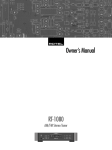
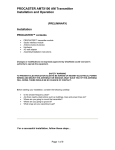
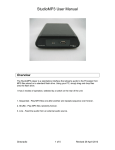
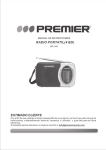

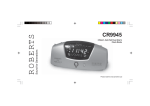
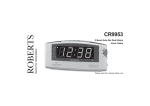


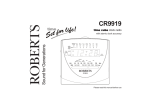
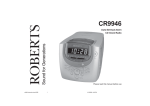
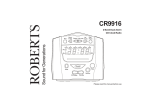

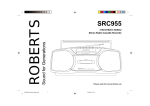
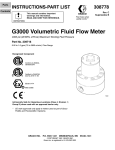

![RessqM, Enhanced Version of RESSQ [Javandel et al., 1984]](http://vs1.manualzilla.com/store/data/005674408_1-e8a4b9f66c80cdc83d847a710e5b4b1f-150x150.png)


